英语人教版八年级下册第二单元SectionB.
- 格式:pdf
- 大小:1.50 MB
- 文档页数:10
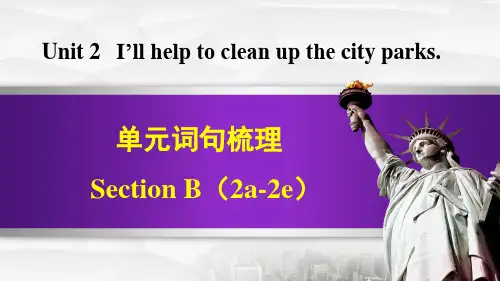
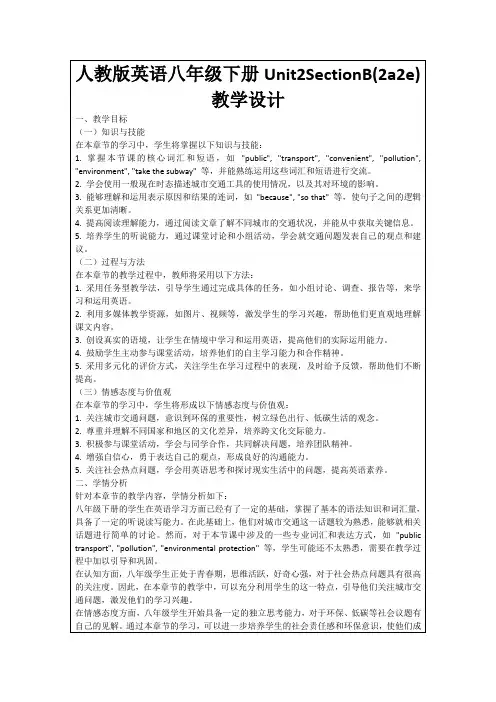
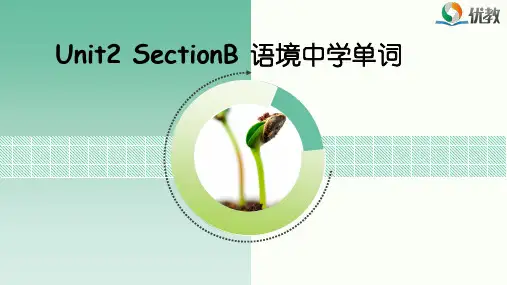
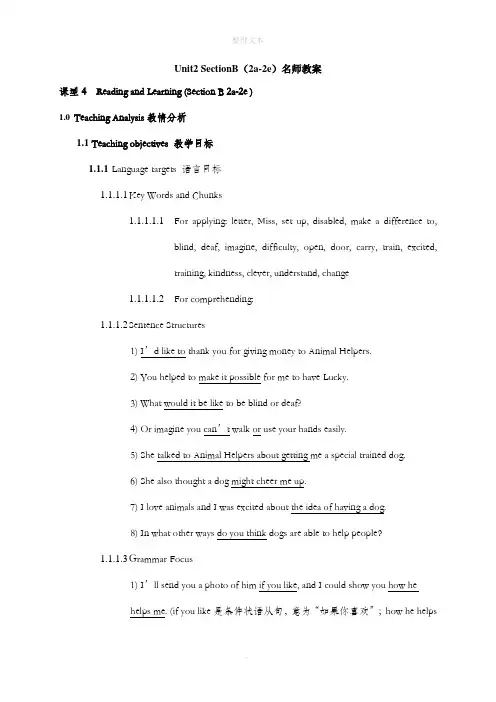
Unit2 SectionB(2a-2e)名师教案课型4 Reading and Learning (Section B 2a-2e )1.0Teaching Analysis教情分析1.1Teaching objectives 教学目标1.1.1Language targets 语言目标1.1.1.1Key Words and Chunks1.1.1.1.1For applying: letter, Miss, set up, disabled, make a difference to,blind, deaf, imagine, difficulty, open, door, carry, train, excited,training, kindness, clever, understand, change1.1.1.1.2For comprehending:1.1.1.2Sentence Structures1) I’d like to thank you for giving money to Animal Helpers.2) You helped to make it possible for me to have Lucky.3) What would it be like to be blind or deaf?4) Or imagine you can’t walk or use your hands easily.5) She talked to Animal Helpers about getting me a special trained dog.6) She also thought a dog might cheer me up.7) I love animals and I was excited about the idea of having a dog.8) In what other ways do you think dogs are able to help people?1.1.1.3Grammar Focus1) I’ll send you a photo of him if you like, and I could show you how hehelps me. (if you like是条件状语从句,意为“如果你喜欢”;how he helpsme是宾语从句,意为“他如何帮助我”)2) I’m su re you know that this group was set up to help disabled people likeme. (was set up是一般过去式的被动语态,一般过去时的被动语态的结构为“was/were+动词过去分词”)1.1.2Ability goals 能力目标1.1.2.1帮助学生通过单词的词性来帮助理解单词在句中的含义。
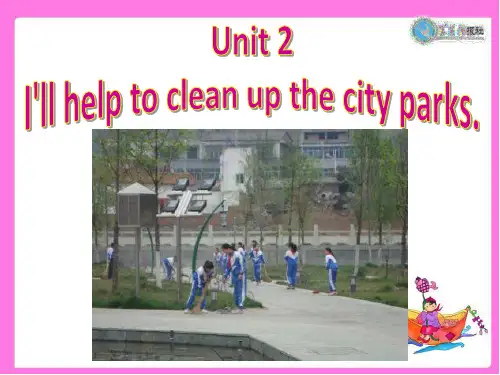
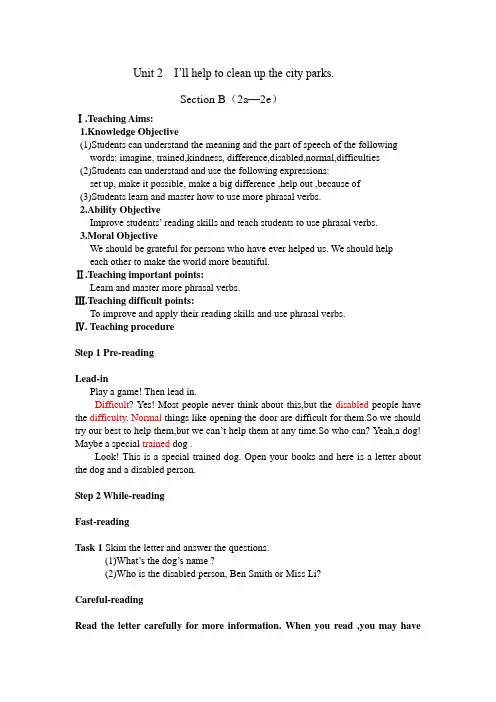
Unit 2 I’ll help to clean up the city parks.Section B(2a—2e)Ⅰ.Teaching Aims:1.Knowledge Objective(1)Students can understand the meaning and the part of speech of the followingwords: imagine, trained,kindness, difference,disabled,normal,difficulties(2)Students can understand and use the following expressions:set up, make it possible, make a big difference ,help out ,because of(3)Students learn and master how to use more phrasal verbs.2.Ability ObjectiveImprove students’ reading skills and teach students to use phrasal verbs.3.Moral ObjectiveWe should be grateful for persons who have ever helped us. We should helpeach other to make the world more beautiful.Ⅱ.Teaching important points:Learn and master more phrasal verbs.Ⅲ.Teaching difficult points:To improve and apply their reading skills and use phrasal verbs.Ⅳ. Teaching procedureStep 1 Pre-readingLead-inPlay a game! Then lead in.Difficult? Yes! Most people never think about this,but the disabled people have the difficulty. Normal things like opening the door are difficult for them.So we should try our best to help them,but we can’t help them at any time.So who can? Yeah,a dog! Maybe a special trained dog .Look! This is a special trained dog. Open your books and here is a letter about the dog and a disabled person.Step 2 While-readingFast-readingTask 1 Skim the letter and answer the questions.(1)What’s the dog’s name ?(2)Who is the disabled person, Ben Smith or Miss Li?Careful-readingRead the letter carefully for more information. When you read ,you may havenew words,don’t worry ! Maybe knowing what part of speech a word is (v, n, adj,etc. ) can help you understand the word’s meaning . Now work in pairs and finish 2c.Task 2 2c Look at the list of word below. Circle the part of speech of each word and make your own sentences with these word.1. group (adj./n.) __________________________2. disabled (adj./adv.) ______________________3. difference (adv./n.) ______________________4. imagine (v./ n.) __________________________5. difficulties (n./ adj.) ______________________6. normal (adv./ adj.) _______________________7. training (adv./n.) ________________________8. kindness (n./ v.) _________________________Third-readingJust now, when you have problems,your partner or your teacher can help you. But who helped Ben Smith ? Read Para 1. Answer the question and finish Task 3. Task3 Choose the right answers.(1)Miss Li gave money to _____ .A. Ben SmithB.LuckyC.Animal Helpers(2)Animal Helpers is set up to help _________.A.animalsB. disabled peopleC. Ben Smith(3)Lucky makes a big difference to__________life.A.Ben Smith’sB.Miss Li’sC. Animal Helpers’What’s wrong with Ben Smith? Read Para 2. Answer the question and finish Task 4.Task 4 Fill in the blanks.(1) Ben Smith is a disabled person. He can’t use his_____________well.(2)It’s ________for Ben Smith to do normal things.(3)Ben’s friend thought a dog might_________ Ben Smith.How does Ben Smith get the dog? Read Para 3&4. Answer the question and finish Task5.Task5 Mark True (T) or False ( F).( ) (1)Ben Smith will send a photo to Animal Helpers.( ) (2)Because of Miss Li’s kindness,Ben has the “dog helper”.( ) (3)Lucky is clever because he can get things for disabled people.( ) (4)After Animal Helpers trained Lucky , Ben brought him home.Task6 2d.Step 3 Post-readingWork in groups and retell the story.In the world , there are not only human beings but alsoanimals .From the passage,we find they help each other and they can be friends.So we should get on well with each other to make the world more beautiful.Homework :Write a summary of the story。
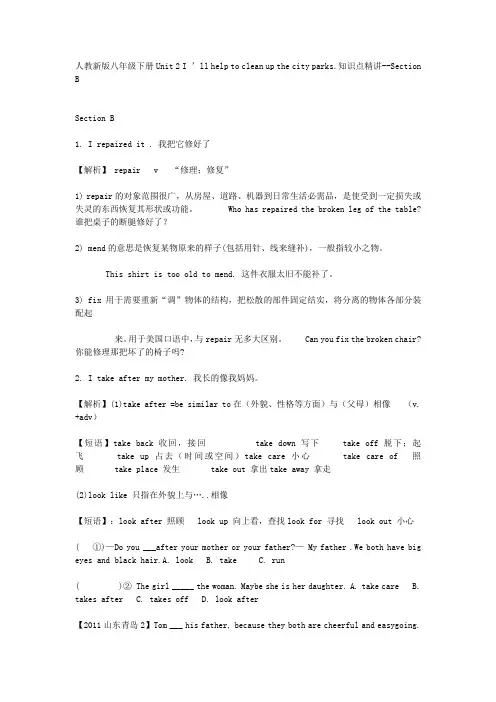
人教新版八年级下册Unit 2 I ’ll help to clean up the city parks.知识点精讲--Section BSection B1. I repaired it . 我把它修好了【解析】 repair v “修理;修复”1) repair的对象范围很广,从房屋、道路、机器到日常生活必需品,是使受到一定损失或失灵的东西恢复其形状或功能。
Who has repaired the broken leg of the table? 谁把桌子的断腿修好了?2) mend的意思是恢复某物原来的样子(包括用针、线来缝补),一般指较小之物。
This shirt is too old to mend. 这件衣服太旧不能补了。
3) fix用于需要重新“调”物体的结构,把松散的部件固定结实,将分离的物体各部分装配起来。
用于美国口语中,与repair无多大区别。
Can you fix the broken chair? 你能修理那把坏了的椅子吗?2. I take after my mother. 我长的像我妈妈。
【解析】(1)take after =be similar to在(外貌、性格等方面)与(父母)相像(v. +adv)【短语】take back 收回,接回 take down 写下 take off 脱下;起飞take up 占去(时间或空间)take care 小心take care of 照顾take place 发生 take out 拿出take away 拿走(2)look like 只指在外貌上与…..相像【短语】:look after 照顾 look up 向上看,查找look for 寻找 look out 小心( ①)—Do you ___after your mother or your father?— My father .We both have big eyes and black hair.A. look B. take C. run( )② The girl _____ the woman. Maybe she is her daughter. A. take care B. takes after C. takes off D. look after【2011山东青岛2】Tom ___ his father, because they both are cheerful and easygoing.A. looks likeB. takes afterC. doesnt’ take afterD. isn’t like3. I fixed it up. 我把它修理好了。
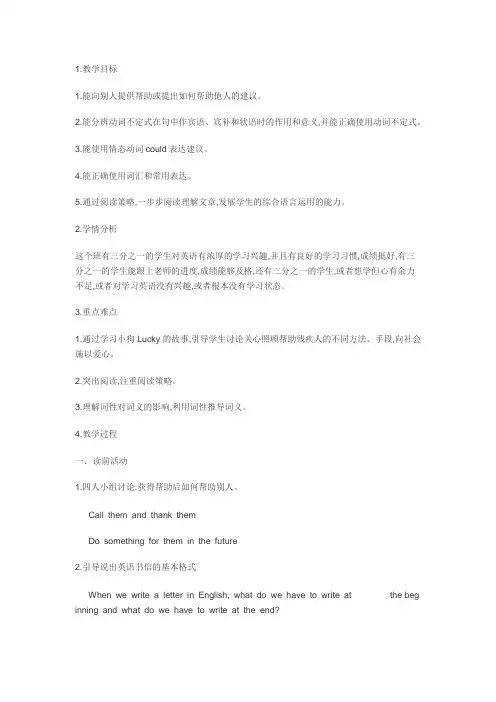
1.教学目标1.能向别人提供帮助或提出如何帮助他人的建议。
2.能分辨动词不定式在句中作宾语、宾补和状语时的作用和意义,并能正确使用动词不定式。
3.能使用情态动词could表达建议。
4.能正确使用词汇和常用表达。
5.通过阅读策略,一步步阅读理解文章,发展学生的综合语言运用的能力。
2.学情分析这个班有三分之一的学生对英语有浓厚的学习兴趣,并且有良好的学习习惯,成绩挺好,有三分之一的学生能跟上老师的进度,成绩能够及格,还有三分之一的学生,或者想学但心有余力不足,或者对学习英语没有兴趣,或者根本没有学习状态。
3.重点难点1.通过学习小狗Lucky的故事,引导学生讨论关心照顾帮助残疾人的不同方法、手段,向社会施以爱心。
2.突出阅读,注重阅读策略。
3.理解词性对词义的影响,利用词性推导词义。
4.教学过程一.读前活动1.四人小组讨论:获得帮助后如何帮助别人。
Call them and thank themDo something for them in the future2.引导说出英语书信的基本格式When we write a letter in English, what do we have to write at the beg inning and what do we have to write at the end?How is a letter different from an article?3.利用插图引导学生进行预测:where is it?Who is Lucky in the picture?What do you think they are doing?二.读中活动1.要求学生快速浏览文章并回答问题,训练学生运用课文信息构建自己的语句。
2.教师先呈现词汇, 然后要求学生再次阅读课文,从中找出这些词汇并标出词性。
3.在确认了词性后,教师呈现选项首先要求学生依据词性初次判断词性,然后再读文章,根据上下文确认自己的判断。
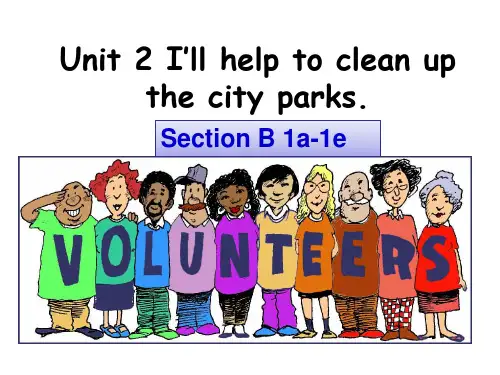
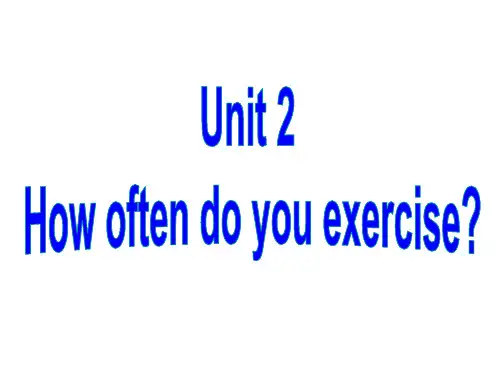
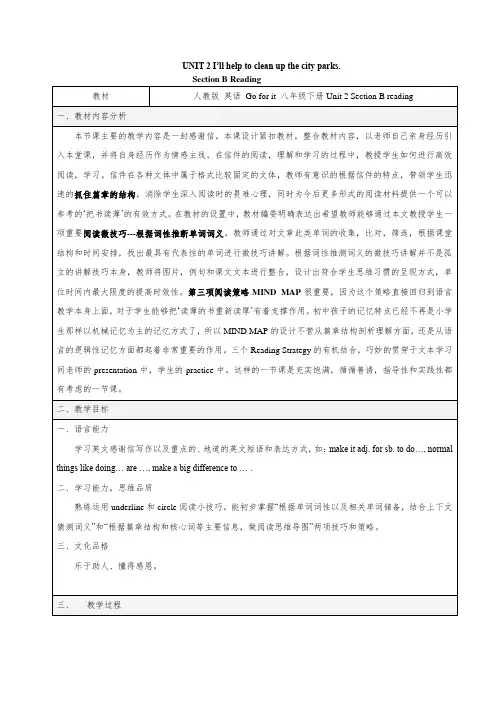
UNIT 2 I’ll help to clean up the city parks.Section B Reading教材人教版英语Go for it 八年级下册Unit 2 Section B reading一、教材内容分析本节课主要的教学内容是一封感谢信。
本课设计紧扣教材,整合教材内容,以老师自己亲身经历引入本堂课,并将自身经历作为情感主线。
在信件的阅读,理解和学习的过程中,教授学生如何进行高效阅读,学习。
信件在各种文体中属于格式比较固定的文体,教师有意识的根据信件的特点,带领学生迅速的抓住篇章的结构,消除学生深入阅读时的畏难心理,同时为今后更多形式的阅读材料提供一个可以参考的‘把书读薄’的有效方式。
在教材的设置中,教材编委明确表达出希望教师能够通过本文教授学生一项重要阅读微技巧---根据词性推断单词词义。
教师通过对文章此类单词的收集,比对,筛选,根据课堂结构和时间安排,找出最具有代表性的单词进行微技巧讲解。
根据词性推测词义的微技巧讲解并不是孤立的讲解技巧本身,教师将图片,例句和课文文本进行整合,设计出符合学生思维习惯的呈现方式,单位时间内最大限度的提高时效性。
第三项阅读策略MIND MAP很重要,因为这个策略直接回归到语言教学本身上面,对于学生能够把‘读薄的书重新读厚’有着支撑作用。
初中孩子的记忆特点已经不再是小学生那样以机械记忆为主的记忆方式了,所以MIND MAP的设计不管从篇章结构剖析理解方面,还是从语言的逻辑性记忆方面都起着非常重要的作用。
三个Reading Strategy的有机结合,巧妙的贯穿于文本学习间老师的presentation中,学生的practice中。
这样的一节课是充实饱满,循循善诱,指导性和实践性都有考虑的一节课。
二、教学目标一、语言能力学习英文感谢信写作以及重点的、地道的英文短语和表达方式,如:make it adj. for sb. to do…, normal things like doing… are …, make a big difference to … .二、学习能力,思维品质熟练运用underline和circle阅读小技巧。
Section B1a1. But my mother wants me to drink it. 但我妈妈想让我喝它。
(教材第12页)want sb. to do sth. 意为“想让某人做某事”,否定形式为want sb. not to do sth. 意为“不想让某人做某事”。
Eg:She wants me to bring him some pens. 她想让我给她带些钢笔。
拓展:1.want sth. 想要某物Do you want any story books?你想要些故事书吗?2.want to do sth. 想要做某事I want to visit my uncle. 我想去看望我的叔叔。
Do you want (tell)me anything?2. She says it’s good for my health. 她说它对我的健康有好处。
(教材第12页)be good for 意为“对……有益”。
反义词为be bad for “对……有害”。
Eg: Vegetables are good for you. 蔬菜对你有好处。
拓展:be good at 擅长... be good at doing sth. 擅长做...I am good at (play)basketball.①Doing sports can help us keep ___________(health)②They eat very ____________(health).③Mike is good for our ____________(health).( ) ④ I think eating more _____ food can help us keep _____.A. health; healthyB. healthy ; healthC. healthy; healthy2b3. Last month we asked our students about their free time activities. 上个月我们向学生询问了他们业余活动的情况。
Unit 2: I’ll help to clean up the city parks.Section B(2a-2b)教案Teaching aims(教学目标)1. Talk about volunteer work2. Offer helpLanguage points(语言点)1. I’d like to thank you for giving money to Animal Helpers.2. You helped to make it possible for me to have Lucky.3. A friend of mine helped me out.4. I was able to bring him home.Difficult points:How to be a good volunteer.Teaching steps(教学步骤)1. Review(复习)Ask, “What did w e learn yesterday?” Have Ss fill in blanks using previously learned phrases. T: Yesterday we learned a lot phrasal verbs. Now let’s challenge ourselves to translate some sentences.教学设计说明:这环节的复习是为后面的阅读作热身。
2. DiscussionT: (present some questions)Can you open or shut the door?Can you carry things?Can you answer the phone?Can you use your hands, arms or legs?(老师可以鼓励学生多说,提高学生的口语)T: Yes, all of you can do these things easily. But some disabled people are not so lucky. Their lives are difficult and challenging. What could we do to help disabled people?Would you like to be a volunteer?教学设计说明:通过讨论,让学生明白健康的重要性并启发他们去思考志愿者工作的伟大与重要性。